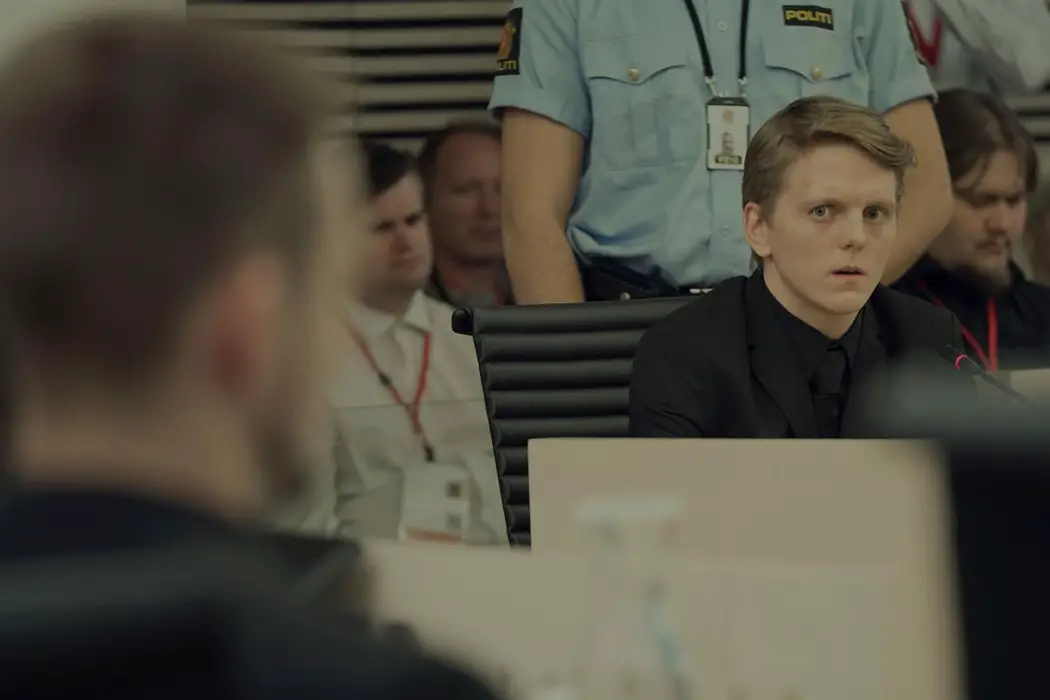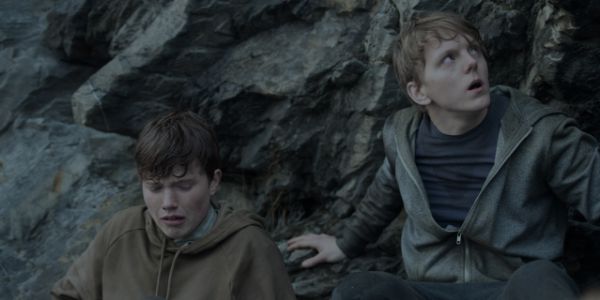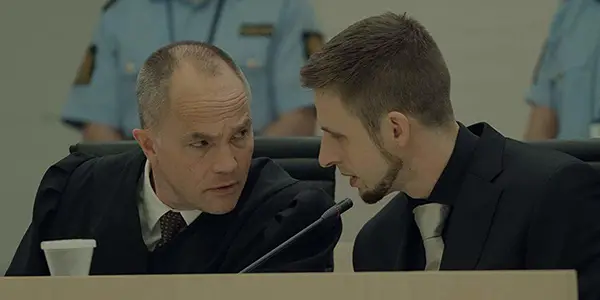22 JULY: Exploring Life After Tragedy In Norway

I'm a student at the University of North Carolina at…
When he isn’t chronicling the globe-trotting adventures of Jason Bourne, writer/director Paul Greengrass makes movies almost solely about the many forms of violence and terror in modern society. His most influential non-Bourne projects are United 93 and Captain Phillips, both detailed, haunting dramatizations of very different events. The former portrays the final hours of the noble passengers on Flight 93 in an unflinching, dramatically minimalist fashion, while the latter depicts Captain Richard Phillips’ intense ordeal at the hands of desperate Somali pirates.
As a result of this trend in his career, Greengrass receives plenty of criticism from those who don’t necessarily agree with his focus on cinematic depictions of terror. That backlash has reached a tipping point with 22 July, a recreation of the horrifying tragedy in Norway that took the lives of 77 people in 2011, many of whom were just children at a summer camp. Why do we need to relive this tragedy? Why show the killer? What are we gaining from a beat-for-beat recreation of such a graphic event?
I must say, I don’t necessarily agree with these particular arguments. The effects of terror linger in our collective consciousness, but they’re often buried deep as abstract events just outside our mental reach. We hear about them, but we can never see them. As traumatic as it may be, maybe we should. Greengrass‘ trademark intensity translates tragedy into concrete representations. The disturbing events we’ve heard about for so long now have a correlation in cinematic form.
The Road From Terror To Recovery
Having said all that in defense of Greengrass‘ aims and goals, 22 July is still a significant misstep for the filmmaker. It is maybe the year’s most acute mixture of raw intensity and crushing tedium, exacerbated by a misguided approach and a lengthy runtime that does the film no favors. The story begins on July 21, 2011, with Anders Behring Brevik (Anders Danielsen Lie) preparing for an attack on a prominent Oslo government building and a state-sanctioned camp on Utøya Island. At the same time, we’re introduced to a group of young men and women at the camp, specifically Viljar Hanssen (Jonas Strand Gravli) and his younger brother Torje (Isak Bakli Aglen).

The next day, the Hanssen family’s life and the lives of so many other families will be irreparably altered forever. We see the bomb go off in Oslo, prompting mass chaos on the streets. Viljar and Torje frantically call their parents (Maria Bock and Thorbjørn Harr), hoping they haven’t been caught in the attack in Oslo. Minutes later, Brevik shows up at Utøya, where he carries out a disturbing massacre of nearly 70 teenagers. Viljar is shot five times, with one wound placing several pieces of shrapnel near his brain. The perpetrator is arrested, leaving Norway to deal with the wake of the attack.
The rest of the film assesses the damage of Brevik’s actions, focusing on both the recovery and bravery of the survivors and the trial of the cruel killer. The recovery narrative is centered on Viljar and (to a lesser extent) Lara Rachid (Seda Witt), who lost her sister in the attack. The legal aspect of the film’s second half shifts much of the attention to attorney Geir Lippestad (Jon Øigarden), who was called upon by Brevik himself to represent him in the trial. Brevik is a right-wing terrorist who believes that he acted in defense of his country, thus putting Norway on trial in the process. That excuse won’t work for the survivors, many of whom will find the strength to stand against him in memory of those they lost.
Horrifying Opening Strikes Powerful Note
Greengrass stages the stomach-churning act of terror with the appropriate amount of tension, practicality, and tastefulness. Even though I believe in the importance of representing these acts of violence in a cinematic fashion, there’s a right way and a wrong way to do it. Thankfully, the first act of 22 July falls firmly into the former category.

The camera never shies away from depicting the horrors of this terrible day. We see children shot multiple times. We’re given frightening access to Brevik’s bomb-making process, as well as his completely measured demeanor throughout the day. We see the aftermath of the attack in Oslo. But even if Greengrass doesn’t try to smooth the edges off the violence, his camera also never lingers on this devastation. His shaky cam-driven style of montage keeps an economical precision to the depiction of the attack, one that never veers into excess.
In broader terms, it never feels like Greengrass is punching anything up throughout the sequence. The film focuses more on the emotional chaos of the day, from the frantic phone calls of parents hoping their kids are okay to the teenagers trying their best to keep it together during an attack. It never feels like the action is being manipulated to intensify the effect, nor does the sequence feature any needless or misguided cinematic flourishes.
For 45 minutes, Greengrass had me watching in total fear, even though I knew what would come next. It’s some of the strongest filmmaking of the year.
Lack Of Focus, Punishing Runtime Lead To Major Struggles
And then the movie continues for 90 more minutes.
Once Greengrass moves past the terrible events of July 22, 2011, he is faced with two choices – depict the brutal road back to normalcy for the victims or chronicle Brevik’s trial. Instead of picking one or the other, the director makes the ambitious (and misguided) choice to take on both stories. In casting his net far too wide, Greengrass stumbles with increasing frequency, failing both his characters and his socio-political themes.
22 July is an explicitly anti-fascist film, exposing and annihilating Brevik’s alt-right associations and extreme white nationalist views. Though the film gives the murderer a lot of screen time (in a decision that’s bound to prompt debate), actor Anders Danielsen Lie‘s portrayal of Brevik is never anything less than terrifying, standing as the chilling personification of pure hatred.

The real problem is the tenuous relationship between the film’s emotional narrative and its more politically conscious aims. For a few moments, it appears that Greengrass is going to go down a route similar to David Gordon Green‘s Stronger, showing how Viljar overcame great physical obstacles in the wake of the unspeakable. But it skips past much of his rehab, moving full steam ahead to a mostly uninteresting trial in lieu of more understated, emotionally satisfying moments (there are a few, but not nearly enough). One of the best scenes comes when Viljar tries to talk to his brother about what happened. His brother won’t open the door, and it’s clear that there are wounds he doesn’t want re-opened. It’s brilliant and tragic. I just wish those scenes of startling honesty were more prevalent.
Frustratingly, even the film’s messages come off as muddled and inconsistent. 22 July wants to scare its audience with a warning of fascism’s impending threat, but by the nature of the story, it’s also required to go for obvious inspirational cues. Greengrass clearly intended 22 July to be a movie about the rise of the radical right (he’s said as much in interviews), even tossing in a few needless throwaway lines from Brevik about his organization’s connections in America. Sadly, the film doesn’t seem to know if it’s about the victims in Norway or if it’s about something bigger, and I don’t know if it fully recovers from that.
I almost wonder if Greengrass would have been better off shifting more of his attention to Lara, an immigrant woman who stands as the embodiment of everything Brevik wanted to destroy. In the current version of the film, she gives a moving speech and convinces Viljar to do the same. Other than that, she’s mostly on the sidelines. With the loss of her sister, her story is completely heartbreaking – so why not make her a more central part of the film?
22 July: Conclusion
This misstep is not an isolated incident. The second half of 22 July is filled with missed opportunities and odd choices. When attorney Geir Lippestad (who apparently made a career out of defending unsavory individuals) enters the picture, the film pivots to a lecture about the necessity of due process and fair trials in the Norwegian system. Not saying it isn’t important, but what is this adding to our understanding of either right-wing terror or the lingering trauma for the victims?
Once again, it’s an issue of scope and focus. Greengrass sets no limitations for himself, so it essentially feels like 22 July is telling a new story by the minute. After such a gripping first half, the impact is now virtually non-existent. An urgent and devastating film suddenly becomes a never-ending slog, destined to leave viewers wondering where things went wrong. It’s a necessary story, told in the most scattered way possible.
What did you think of 22 July? Have you been impressed by Paul Greengrass’ previous cinematic portrayals of tragedy? Let us know in the comments below!
22 July was released on Netflix and in select theaters on October 10, 2018.
Does content like this matter to you?
Become a Member and support film journalism. Unlock access to all of Film Inquiry`s great articles. Join a community of like-minded readers who are passionate about cinema - get access to our private members Network, give back to independent filmmakers, and more.
I'm a student at the University of North Carolina at Chapel Hill. For 8 years, I've edited the blog Martin on Movies. This is where I review new releases, cover new trailers, and discuss important news in the entertainment industry. Some of my favorite movies- Casablanca, Inception, Singin' in the Rain, 2001: A Space Odyssey, The Wolf of Wall Street, The Nice Guys, La La Land, Airplane!, Skyfall, Raiders of the Lost Ark. You can find my other reviews and articles at Martin on Movies (http://martinonmovies.blogspot.com/).













